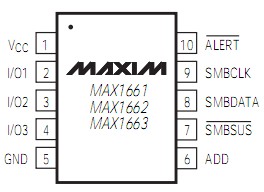MAX1661: Features: Performs Serial-to-Parallel and Parallel-to-Serial ConversionsThree General-Purpose Digital Input/Output Pins (withstand +28V)SMBus 2-Wire Serial InterfaceSupportsSMBSUS Asynchronous Suspe...
floor Price/Ceiling Price
- Part Number:
- MAX1661
- Supply Ability:
- 5000
Price Break
- Qty
- 1~5000
- Unit Price
- Negotiable
- Processing time
- 15 Days
SeekIC Buyer Protection PLUS - newly updated for 2013!
- Escrow Protection.
- Guaranteed refunds.
- Secure payments.
- Learn more >>
Month Sales
268 Transactions
Payment Methods
All payment methods are secure and covered by SeekIC Buyer Protection PLUS.

 MAX1661 Data Sheet
MAX1661 Data Sheet







